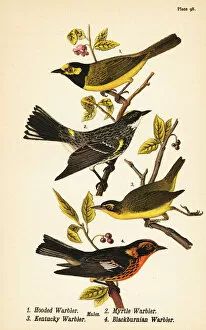Geothlypis Formosa Collection
The Kentucky Warbler, scientifically known as Geothlypis formosa, is a captivating bird species that never fails to amaze with its vibrant appearance and melodious songs
All Professionally Made to Order for Quick Shipping
The Kentucky Warbler, scientifically known as Geothlypis formosa, is a captivating bird species that never fails to amaze with its vibrant appearance and melodious songs. With its striking yellow underparts and bold black hood, this avian beauty stands out among the crowd of warblers. Often found in dense thickets and understory vegetation of deciduous forests, the Kentucky Warbler is a master at hiding from prying eyes. Its preferred habitat provides ample cover for this elusive creature to forage on insects and spiders while remaining hidden from predators. Although it shares similarities with other warbler species such as the Hooded Warbler (Setophaga citrina), Yellow-rumped Warbler (Setophaga coronata), and Blackburnian Warbler (Setophaga fusca), the Kentucky Warbler possesses unique characteristics that set it apart. Its distinctive song echoes through the forest, a rich melody that can be easily distinguished by experienced birdwatchers. During breeding season, male Kentucky Warblers showcase their devotion by tirelessly singing to attract mates. Their melodic tunes fill the air as they establish territories within their chosen woodland domain. Meanwhile, females diligently construct cup-shaped nests on or near the ground where they will lay their precious eggs. As summer transitions into autumn, these migratory birds embark on an incredible journey towards their wintering grounds in Central America. Along this arduous migration route, they face numerous challenges including weather hazards and loss of suitable habitats due to deforestation. Conservation efforts are crucial to ensure the survival of not only the Kentucky Warbler but also countless other bird species facing similar threats. By preserving their natural habitats and raising awareness about these magnificent creatures' importance in maintaining ecosystem balance, we can help protect them for generations to come. So next time you find yourself immersed in nature's embrace, keep your ears open for that distinct song echoing through the trees – it might just be a charming Kentucky Warbler, reminding us of the beauty and fragility of our natural world.


